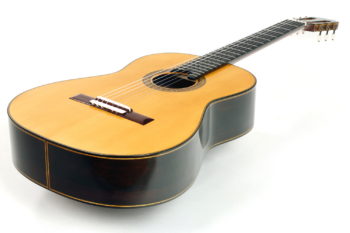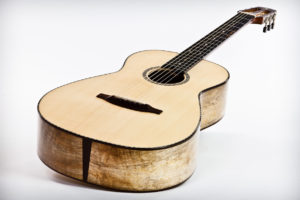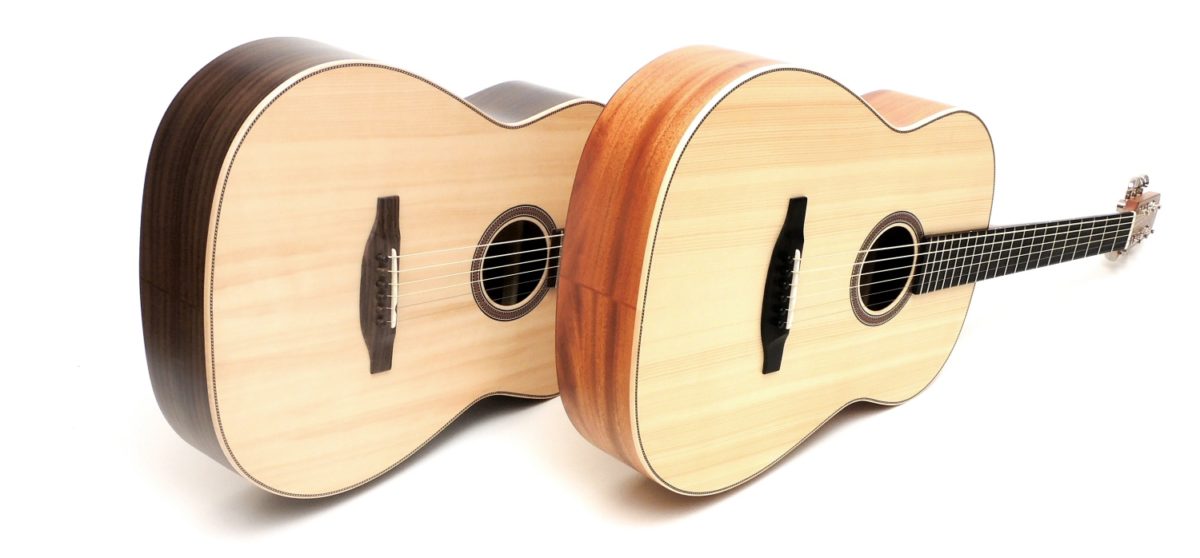
12-fret guitars are characterised by neck-body-transition at 12th fret. Basically, this is the case with all classical guitars. However, this article is about the steel string guitar which developed from the classical guitar.
To understand today's 12-fret guitar, we not only have to take a look at the development of the guitar, but also deal with the 14-fret guitar.
12-Fret Construction
The classical guitar is the template for all subsequent acoustic guitar types. The design of the 12-fret guitar, like many other musical instruments, is based on the golden ratio. The result, among other things, is a bridge that is positioned in the center of the vibrating part of the top. This allows for optimal vibration. The vibrating part of the top is the area below the sound hole. Vibrated by the strings, the guitar top works like an air pump and transports the sound out of the body. This works best when the bridge is positioned where it can take the greatest influence on the movement of the top.
Short History of the Steel String Guitar
The steel string guitar developed from the classical guitar in 19th century North America. A high demand for simple musical instruments, which were easy to transport, easy to learn and financially affordable, meant that the expensive gut strings of the classic guitar were quickly replaced with inexpensive wire.

Unfortunately, the need for a louder instrument grew in the 20s / 30s of the last century, as the guitar was increasingly used in bands and had to prevail against banjos. Along with the banjos came the desire for a longer neck. This was fateful for the further development of the steel string guitar. The 14-fret guitar was born.
12-Fret to 14-Fret
Maintaining the scale length, there were two ways to move the neck-body transition. The first possibility was to move bridge, sound hole and neck upwards. The consequence would be that the bridge is no longer at the optimal location for tone generation.
The second possibility was to reduce the body instead, respectively the upper bout. As you can easily see from the photomontages shown, these changes would give an absolutely inharmonious picture and it is obvious that a guitar based on this principles would not sound very good.
The shifting of the neck-body-transition had to be followed by a variety of structural changes. Most of today's 14-fret guitars are characterised by a shorter upper bout and a bridge shifted upwards from the center of the top.

12-fret Back and Forth
The first wire stringed guitars still had a very rudimentary bracing. The enlargement of the body and the longer neck also required a much more elaborate top bracing.
Although Martin already used the well-known X-bracing, they were also forced to make adjustments to the cross, as the stronger string tension caused the top to bulge behind the bridge. The optimal position of the X-bracing was not found until the end of the 1930s.
Further developments of the inner life, triggered by the steel strings, were e.g. the stabilisation of the longer neck by the (today) adjustable truss rod or the scalloped bracing, in order to stabilise the top against the string tension, but to preserve its vibration capacity as much as possible.
All these developments were initially carried out on 14 fret guitars, but have long since been implemented in 12 fret guitars as well, as a matter of course.
12-Fret Sound
12-fret guitars appear wonderfully harmonious and impress with a rich midrange. As a result of the 12-fret-construction, the full sound is focused on the low mids and the bass range. Therefore the luthier is in charge to build a top bracing emphasising the treble an thus achieving a balanced sound.

To simulate the sound of a 12-fret-guitar with a 14-fret-guitar is to a certain extent possible, but even the best guitar builder cannot spoil the laws of statics. They simply have different vibrational dynamics.
12-Fret Playability
The shorter neck allows for a lot more comfort. The fingerboard of a 12-fret guitar is easier to access. The guitar is more ergonomic for the back and the arms of the player. It is even easier to play, provided the bracing does not work against the natural dynamics between the bridge position and the top. The top of a 12-fret-guitar is much more flexible, because the bridge is placed in the middle of the vibrating area and thus provides the largest possible stroke.

To understand what's happening here, take a look at the lifting of a heavy object. Closer to body, an object is lifted easier than with outstretched arms. Now replace "body-centered" with "bridge position" and "outstretched arms" with "shifted bridge position".
12-Fret Playing Techniques
12-fret guitars are great for fingerpicking. The development of the sound is optimally supported by the vibrating dynamics of the top. They are not very suitable for strumming with a hard plectrum. The extensive vibration of the top would lead to a frequency overlay and thus to undesired acoustic side effects.
STOLL 12-Fret Guitars
If you want to trace the roots of steel-string guitar, you will find the following 12-fret guitars:

